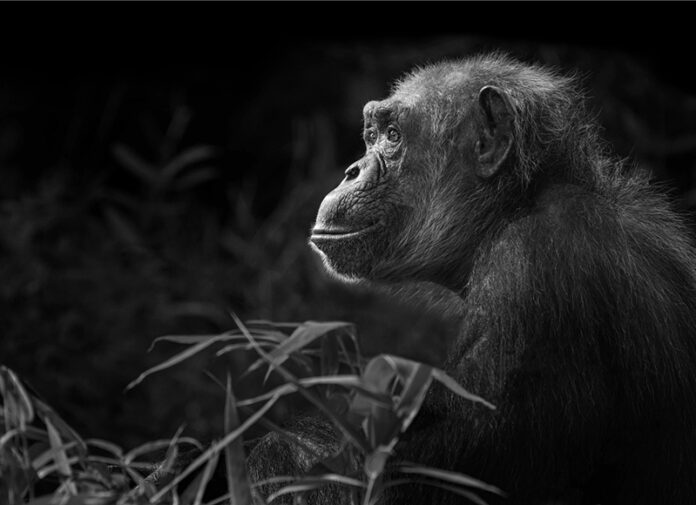The World of Primate Photography
by Shawna Hinkel
Deep Breath. Camera steady. Focus locked. It’s a beautiful, sunny morning, and there is a slight chill in the air. My lens is pointed at a clearing in the foliage in front of me where the sunlight is making the grass almost glow. I wait, knowing what I want, and, eventually, a female chimpanzee named Ramona walks into my frame and sits in the perfect spot. Click. Exhale. I smile because I know I got the image I have been anticipating for more than an hour, and then she gets up and continues on her way to a better sleeping spot in the shade. I look around at the rest of the troop and notice everyone has settled down for a nap after breakfast, so I am finished for now. I gather my gear and say “Goodbye” to the chimps until next time.
That was eight years ago. I have been photographing primates all over the world since that amazing day. The image of Ramona, “The Thinker” (Cover Image) is one of three award-winning images created that day, and the beginning of my “Almost Human” series. It is still one of my favorites.
Primates are fascinating, and my work focuses on the Great Apes, which include Orangutans, Gorillas, Chimpanzees, and Bonobos. Their expressiveness is captivating, the interaction between the adults and the juveniles is precious, and their personalities are so distinct. Some animals shy away from the camera (or turn their backs completely!), but some actually seem to pose, and every now and then I see what appears to be a smile. Therefore, my collection of images shows a wide range of emotions. Some of the images are serious, some are playful; some are portraits, some are more environmental; some will make the viewer smile, others sad. Every day with these animals is different, so the images are always different. My goal is to show them in all their glory, and I hope people can appreciate the beauty of these wonderful creatures as much as I do.
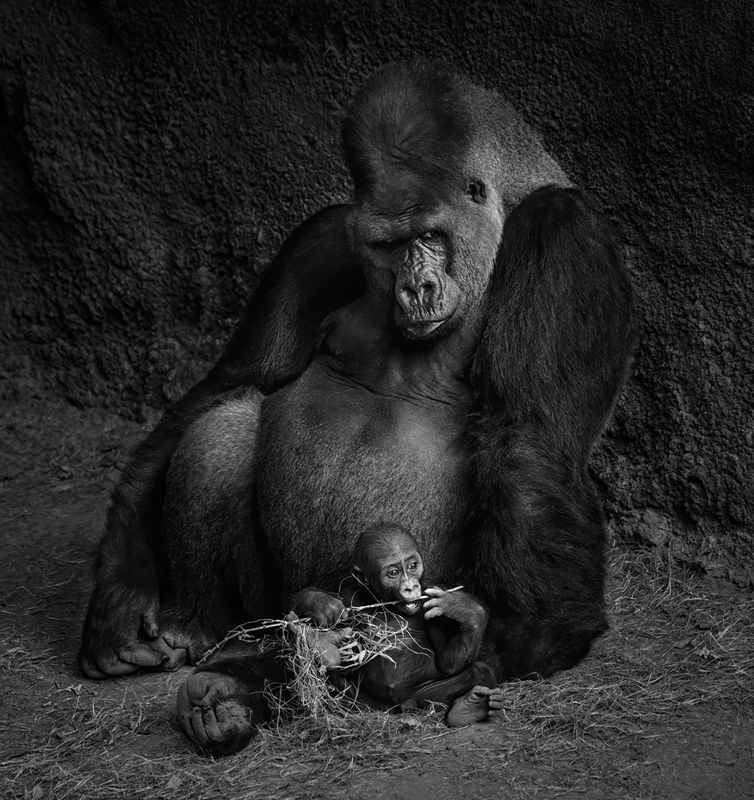
“Daddy’s Sidekick” is an image that touches my heart and is a good example of how primates interact with me and with each other. Subira was the giant silverback gorilla and head of the family. The first time I tried to photograph him, he glared at me and turned his back on me. Twice. It was not an accident, but an act of defiance! A few years later, he had a new son, Mbani, and I was thrilled to see them spending time together. I did not see him interact with his children very often, so I was really excited to photograph them, but I did not know how he would react. He was such a good father and kept a close eye on his son, but also watched me to make sure I was not a threat. I captured their adorable interaction in this image and was heartbroken when Subira passed away five months later.
Photographing wildlife is both rewarding and challenging. No matter where you are, you have to deal with the environmental elements including too much or too little sunlight, sleepy subjects who do not do anything worth capturing, shy subjects who hide, temperamental subjects who are in a full-on pout mode (yes, I have seen this one!), juveniles who move too fast to capture anything good, and habitats that do not allow access to the best views of the animals. And, of course, you must get the best exposure, color, expression, catchlights, and – fingers crossed – eye contact to make a compelling and impactful image. But patience is key to the reward. People looking at my images often ask how far away I was from the subject or how I captured such beautiful light, so having the right gear (I shoot a Nikon D850 with a Nikkor 200-500mm f/5.6 ED VR lens) and knowing your camera are vital, but patience is the most important aspect of what I do. Spending time with the animals and getting to know them is also valuable so they get used to me and the camera, and they seem to remember me. I have spent hours observing the animals, learning their behaviors, and waiting for them to do something I expect them to do or, even better, something more interesting than I can even anticipate.
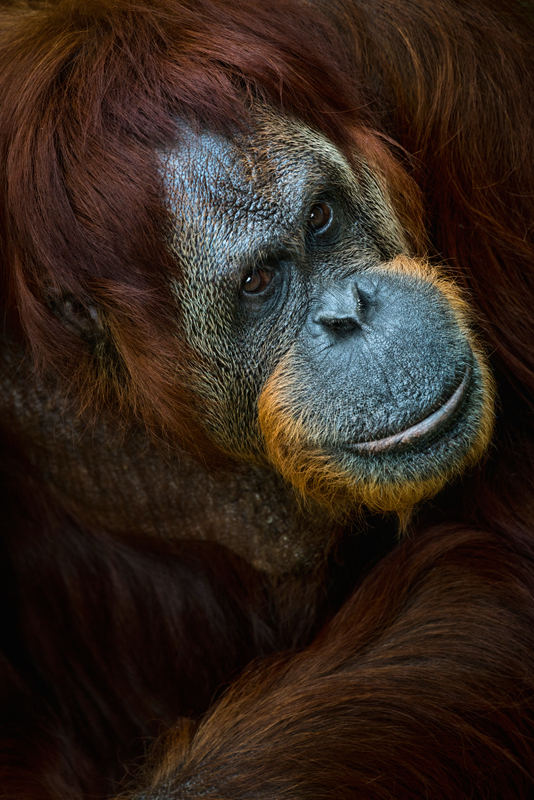
The day I captured “Feeling Blue,” I spent several hours with the orangutans, but they were napping. Every time one of them got up to stretch, I grabbed my camera in anticipation, but the two females just looked at me and laid back down. One of them even kept putting her hands over her face and peeking at me through her fingers. She was the one that most interested me. PT is a hybrid orangutan (a cross between a Sumatran and a Bornean orangutan). She is the most colorful one I have seen, so I really wanted to photograph her, but I feared I was annoying both of them as I waited and watched. Eventually, she got up, came closer, and laid down in the shade to play with the blades of grass. Then, for a single moment, she looked up at me. The light, pose, and expression were perfect, and it was a much better image than I expected from my day so far. I captured the image and thanked her for her cooperation before I left. She is still one of my favorite subjects.
These amazing animals are intriguing to watch, and we learn things regularly that make them seem even more like us. Earlier this year, scientists in Sumatra witnessed an orangutan use a medicinal plant to treat an open wound on his cheek. Chimpanzees have long been known to make and use tools. These are our closest living relatives, and we should also be doing everything we can to protect them. The great apes are all critically endangered species, which makes bringing awareness of them even more important to the world. The main threats they face are habitat loss and poaching. Unfortunately, humans – the fifth primate in the Great Ape family – are responsible for both. If people can learn to look at them as more than just trophies or pests to be dealt with, maybe we can learn to co-exist peacefully. These animals are so much like us, it would be a tragedy to lose them.
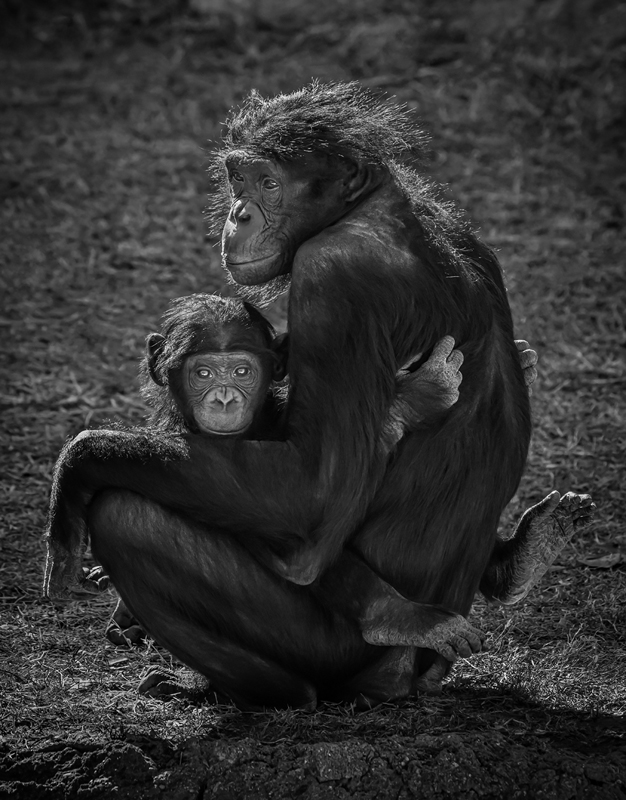
“Mommy and Me” features bonobo Johari and baby Asali. They were so sweet cuddled up together. But, babies being babies, Asali could not sit still for long and ended up climbing all over her mother and earning several annoyed looks to calm down. In the meantime, I captured many adorable expressions from this cutie being ornery. Asali is the future. She runs around with the troop, playing and getting into things, and the troop protects her. She will one day have new bonobos of her own to continue the conservation efforts for the species. Her survival is essential.
There are many places to photograph wildlife, no matter where you live. There are zoos and animal reserves around the world, and, of course, Africa is any animal photographer’s dream location. In my experience, the best time to photograph wildlife is in the early morning when the sun is lower and the light is softer, and the animals tend to be more active in the cooler temperatures around breakfast time. Weekdays when the crowds are smaller so the environment is quieter is also a good idea. I personally support accredited zoological associations because they create wonderful facilities and help with conservation efforts for many species. It is wonderful to see people working hard to bring endangered species back from the brink of extinction and increase their numbers in the wild so people will be able to admire these amazing creatures generations from now. If only we could understand the consequences of our actions and undo the damage we have done, what a better world it would be for man and apes alike.
To view the “Almost Human” series, visit www.wanderlustfineartistry.com.
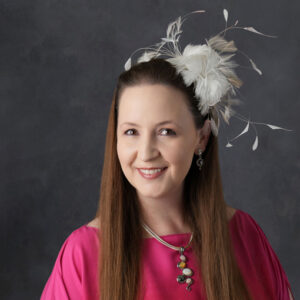 Shawna Hinkel is a Master Photographer and Certified Professional Photographer from Dallas, Texas. She has a Bachelor of Science in Journalism from Texas A&M University, and has been a professional photographer since 2004. She earned her PPA Certification in 2014 and PPA Master of Photography degree in 2019. She was awarded Life Membership in Dallas PPA in 2020, and earned her Accredited Professional of Animal Imagery degree in 2021. In 2023, she became the second Master of WPE from the United States and also became a Master Photographer in Fine Art from MPI. Her work has been accepted in the PPA International Photographic Competition Annual Exhibition every year since 2016, with images published in the annual Showcase Collection and Loan Collection books as well. She was the Dallas Professional Photographers Association Photographer of the Year in 2017 and 2018 and was named as one of the Top 10 photographers in Texas in 2020. She also received the American Society of Photographers’ State Elite Award in 2020. She has won a variety of other awards and has been featured in multiple art gallery exhibitions.
Shawna Hinkel is a Master Photographer and Certified Professional Photographer from Dallas, Texas. She has a Bachelor of Science in Journalism from Texas A&M University, and has been a professional photographer since 2004. She earned her PPA Certification in 2014 and PPA Master of Photography degree in 2019. She was awarded Life Membership in Dallas PPA in 2020, and earned her Accredited Professional of Animal Imagery degree in 2021. In 2023, she became the second Master of WPE from the United States and also became a Master Photographer in Fine Art from MPI. Her work has been accepted in the PPA International Photographic Competition Annual Exhibition every year since 2016, with images published in the annual Showcase Collection and Loan Collection books as well. She was the Dallas Professional Photographers Association Photographer of the Year in 2017 and 2018 and was named as one of the Top 10 photographers in Texas in 2020. She also received the American Society of Photographers’ State Elite Award in 2020. She has won a variety of other awards and has been featured in multiple art gallery exhibitions.



